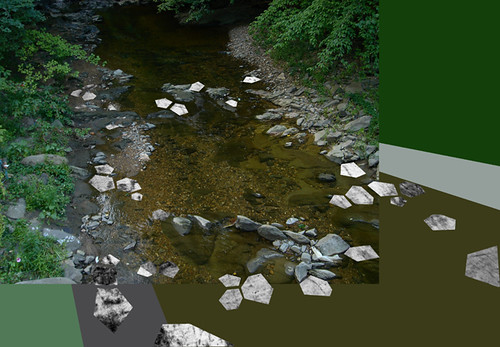
There was a desire to identify and connect some processes at work in the city:
(1) The process of abandonment and dereliction that produces unplanned open space. Some of this space is acquired by municipalities on the scale of the block, the neighborhood, the city - and turned from dross to amenity. Lots, alleys and fields become rights-of-way, paths, gardens, parks ... or else they're thrown back into the mill for reuse and more building.
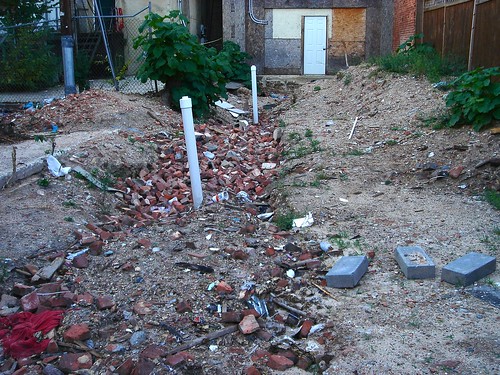
(2) The process by which invasive plant life colonizes and takes apart the remnants of the hardscape, opening it up again to wind and rain. Paulownia and Ailanthus trees are foreign species from asia, where they are revered for their medicinal and symbolic value. Here they are uncultivated and volunteer opportunistically, growing quickly where other plants would find no root, scorned as weeds and pulled when unwanted. (shoutout to Kio and Neil from the Working Group for spreading this obsession)
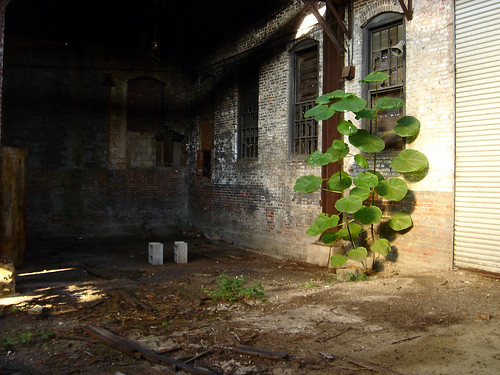
The site at Winans Meadow offered a chance to link these ideas together. The underused Winans family estate was purchased by the city in 1941, it's been a city park since at least 1948. The site has had a reputation as a dumping ground - this is maybe related to the presence of strange ruins dating from around the civil war, including a large broken water wheel, a stone root cellar and a guardhouse.
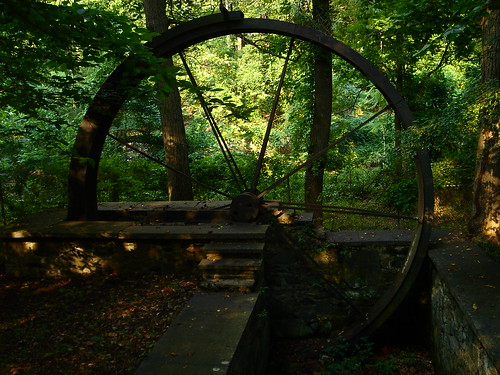
This project takes the detritus from the constant construction and destruction of Baltimore's built environment - broken bricks and scrap boards - into the park to form new patterns and structures embedded in the ground like reverse archaeology, fresh hardscape with an invented history, waiting to be discovered by visitors, with a form that grows and spreads across the landscape.

Construction imposes built geometry on open space, and as a lot becomes fallow again, growth imposes it's own order as another overlay. The choice to use nonstandard variable geometry instead of a more repetive system was an attempt to collapse these two systems into one. Voronoi and Mesh are the new (pseudo-organic) grid.

That's the intention, anyway, the vagaries of execution tend to distort and dilute things into other things.
The whole deal depended on the use of found scrap material. There were time constraints - a deadline on another thing slipped, and ended up overlapping the start date for this one. The entire project had to be finished - materials located, gathered, transported, unloaded, staged and installed - in an evening, a lunch break, and a half day off work. Also, time spent to embed each piece in the ground was way underestimated. The boards made it in, just barely, the bricks didn't.
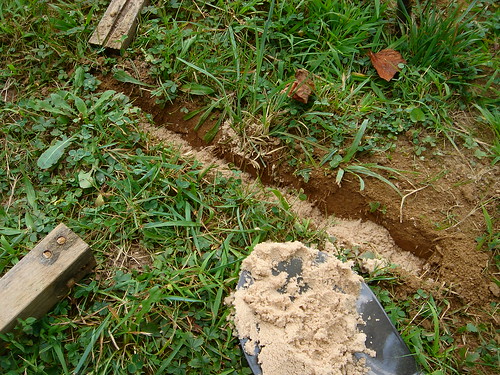
There were size constraints - the outer bounds of a given piece were determined by the carrying capacity in a trunk of a not-very-large-car. A lot of promising scraps were left on the table for being too big. This limited the connection distance between points, and the overall scale of the installation - more smaller pieces had to do the work of fewer larger ones. Setting up the systems as open-ended fields allowed the pieces to be composed on-the-fly, and the whole project could be scaled up or down as time and materials allowed.
The scale worked out - the Voronoi board network fit around and between the grid of newly planted farm trees at the top of the hill. There were other lucky coincidences, including the discovery of a hardware/lumber store about 5 blocks from the site, useful to get sand for paver beds and a hammer for tapping things into place. Craft and constructibility was another issue - digging, lifting, clearing and hammering is hard work, there are blisters to prove it.
There are always other things: weather, seasons, and unplanned connections. There is the idea here, as has been seen before, of a ground made of stuff - a seemingly solid base that's actually built up of found material from elsewhere. The opening was scheduled for Saturday, the same day that Hurricane Hannah drenched the northeast. The tour was canceled but the rain washed away the remnant scraps of dirt and joined the pieces to the ground in a way that no shovel could've.
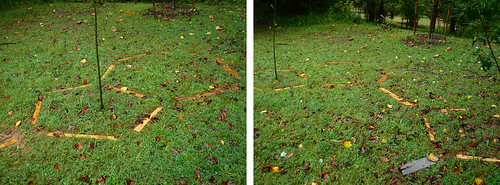
In the above photo, the distorted grid of bricks is barely visible in the background, It is early fall now that the installation is in, and the leaves blur the color and obscure the geometry in an unexpected, but not-unwelcome way.
We've got kind of a catch phrase in Baltimore, when a project doesn't turn out the way you expect, you say something like: "Oh yeah, this is just the trial run, now that we know how it works, it'll be awesome when we do it for real."
So there's a bunch of sculptures in Leakin Park right now, if you're around Baltimore anytime before mid October, go see 'em, and don't miss Doug Retzler's 40 ft sundial made of light poles and railroad ties, he did it for real.

6 comments:
This is awesome, Fred.
Hey 765, it's mo, from Yale back a few years ago, que onda? I saw something back in '03 in a mag somewhere, some italian? designer, it was an italian mag, so, guy physically painted? taped? red lines all over the landscape, image at first glance looked like a photo that somebody drew red lines on, and the red lines formed some geometry that looked normal but then a few images followed and they were from different angles and the red lines were everywhere, painted around corners, in perspective, etcetera, great stuff, those images you posted reminded me of that, thought you might know of him, if you do, let me know, i've been looking for several years, can't seem to find him.
Really effective material, thanks so much for the post.
It won't work in actual fact, that's exactly what I suppose.
Quite useful info, much thanks for the post.
I fully match with the article.
Post a Comment